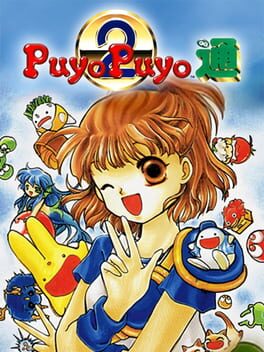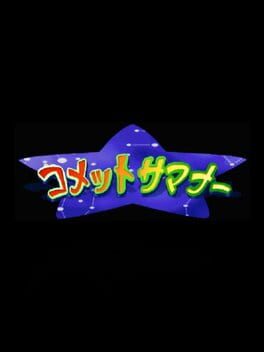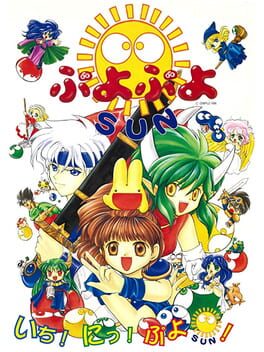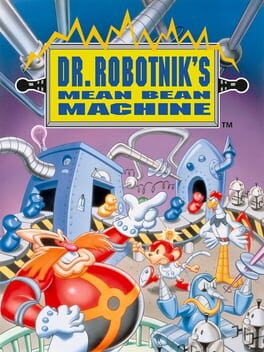

The object of this head-to-head puzzle game is to clear your grid of falling patterns, called puyos, by forming chains of four or more same-colored puyos in a straight line or one of several geometric patterns. What makes this a challenging two-player contest is the fact that when you clear a chain of puyos from your grid, it drops a random piece of filler onto your opponent’s grid. The more puyos you clear, the more you fill your opponent’s grid, and if you can clutter up his grid enough to fill it to the top, you’ve won the game. An intriguing backstory makes this an amusing experience for one or two players.
Also in series
Reviews View More
Sometimes in life, when you strive to achieve something, but you keep failing at reaching that goal, you just gotta take a step back and realize… you will never reach that goal, and you should stop trying. Kind of a depressing reality, I know, but that was the reality I had to face when I tried to beat the original Puyo Puyo. It was a very simple puzzle game, one that many of us know and love, and one that I was able to get a handle of for a good couple of matches or so, until the game grabbed me by the wrist, threw me against the wall, and proceeded to crush all of my hopes and dreams while I could do nothing but watch and feel bad. It was somewhat discouraging, but hey, at the end of the day, I still managed to have a good time, and that’s all that matters. It just goes to show that, even if I do suck at something, I can still manage to have fun doing it (like reviewing things), so I figured I may as well go ahead and give the series another chance with Puyo Puyo 2- oh, wait, shit, fuck, bitch, tit, I’M SORRY… I meant Puyo Puyo Tsu… because Japan.
The idea of giving this game a proper review wasn’t something that I thought wouldn’t be necessary, and for those who aren’t familiar with it, upon first glance, you could see why. When you compare the two, this seems like it's just an update to the original and nothing more, not just in terms of graphics and style, but also in terms of gameplay, with very little changes made to the formula to make it seem like a proper evolution of the series. However, I then went ahead and did a little digging, and after playing it a bit more, I realized that there was more going on here then I realized. So, with these changes in mind, while I wouldn’t say this is a massive step-up in quality from the original, I would say that this is definitely the superior game of the two, and one that does manage to change up just enough to where it can be enjoyed by more due to the original’s limitations.
In many ways, it is practically identical to that of the original, having the same graphics and graphical style, having the same type of music, same control, same gameplay, basically if you have played Puyo Puyo 1, you have played Puyo Puyo 2 without even knowing it. The only real change is with the story, but even then, it is barely even noticeably different, as not only is it very similar to the original game’s plot, but it is a puzzle game, so nobody gives a shit about the plot! You are still just dropping goo guys down, matching them up, clearing them out when you match four of them at a time, and you can chain combos together to send loads of garbage over to your opponent and prove that you are the true ruler of this game. Any fan of Puyo Puyo can jump in and have a great time with it, as it still is pretty fun to play, and whenever you overcome a strong challenge, it does feel pretty good to pull off.
All of that is well and good, yes, but again, if you are unfamiliar with the game, you may just think it is Puyo Puyo 1 again, so why would you bother playing it over the original? Well, that would be because, for this game, several changes were made to the gameplay and the mechanics, which would not only become staple parts of the series, but would propel the series further into that spotlight where it comfortably sits now. The first of these new mechanics, known as “Offsetting”, makes it so that, whenever you clear out a set of Puyo, and you create clear Puyo to throw down onto your opponents screen, it can clear out any clear Puyo that your opponent had sent over to your side of the screen at that time. That way, you can prevent them from dumping tons of clear Puyo onto your side, and if you are fast enough, you can then send plenty of your own clear Puyo onto their side to screw them over. This, while not sounding like too much of a big change, is an incredible change to the formula, as it gives you the chance to keep yourself from being completely fucked over by opponents, while also not letting the gameplay get too easy to the point where it becomes boring… at least, for me anyway.
The second of these mechanics, known as “margin time”, makes it so that, as the match keeps going, the amount of clear Puyo that one can send to their opponent at a time increases, meaning that, if luck is in your favor, you can turn the tides on a match quickly and keep yourself in a calm, controllable state, while your opponent will be panicking, trying to figure out what to do to come back from what you did. Once again, this change isn’t anything too major, but it does help from keeping matches from going on forever, and again, when you are able to take proper advantage of these changes as the game goes along, it does feel pretty rewarding to do so. And finally, for certain versions of this game, there were several other modes that were made available to play on, such as a practice mode, and one that even allowed up to four player battles. While I myself don’t ever see myself ever trying to seek out these modes in this game, it is cool that that option does exist for those who are fans of the game.
Aside from all that though, there isn’t much I can say about this game that I haven’t already said back when I reviewed the original. It really is mostly just another Puyo Puyo game, and while there are brand new rules in place that make the matches in the game a little more bearable, it doesn’t really give much of an incentive for fans of the original to jump headfirst into it. But then again, from what I could gather, there really won’t be any major changes to the formula until Puyo Puyo 4, so really, I shouldn’t expect too much from these games anyway. They are still pretty fun regardless in the right circumstances, and I am glad that I still decided to give it a shot, even if I still completely suck at it.
Overall, despite a lack of major changes when compared to the original, Puyo Puyo 2 is pretty much a superior version of the original game, keeping the core fundamentals the same, while still being fun as ever, and adding just enough tiny changes to make the experience more preferable over the original any day of the week. I would recommend it for those who are huge Puyo Puyo fans, as well as those who are big puzzle game fans in general, but for everyone else, I would probably just stick to later titles in the series over this one. Although, even then, I’m not even sure I can say that this one is genuinely better then the original, because it never got its own version with Kirby in it. Any true fan of the series would know that that was where it peaked, and it has been downhill ever since.
Game #529
The idea of giving this game a proper review wasn’t something that I thought wouldn’t be necessary, and for those who aren’t familiar with it, upon first glance, you could see why. When you compare the two, this seems like it's just an update to the original and nothing more, not just in terms of graphics and style, but also in terms of gameplay, with very little changes made to the formula to make it seem like a proper evolution of the series. However, I then went ahead and did a little digging, and after playing it a bit more, I realized that there was more going on here then I realized. So, with these changes in mind, while I wouldn’t say this is a massive step-up in quality from the original, I would say that this is definitely the superior game of the two, and one that does manage to change up just enough to where it can be enjoyed by more due to the original’s limitations.
In many ways, it is practically identical to that of the original, having the same graphics and graphical style, having the same type of music, same control, same gameplay, basically if you have played Puyo Puyo 1, you have played Puyo Puyo 2 without even knowing it. The only real change is with the story, but even then, it is barely even noticeably different, as not only is it very similar to the original game’s plot, but it is a puzzle game, so nobody gives a shit about the plot! You are still just dropping goo guys down, matching them up, clearing them out when you match four of them at a time, and you can chain combos together to send loads of garbage over to your opponent and prove that you are the true ruler of this game. Any fan of Puyo Puyo can jump in and have a great time with it, as it still is pretty fun to play, and whenever you overcome a strong challenge, it does feel pretty good to pull off.
All of that is well and good, yes, but again, if you are unfamiliar with the game, you may just think it is Puyo Puyo 1 again, so why would you bother playing it over the original? Well, that would be because, for this game, several changes were made to the gameplay and the mechanics, which would not only become staple parts of the series, but would propel the series further into that spotlight where it comfortably sits now. The first of these new mechanics, known as “Offsetting”, makes it so that, whenever you clear out a set of Puyo, and you create clear Puyo to throw down onto your opponents screen, it can clear out any clear Puyo that your opponent had sent over to your side of the screen at that time. That way, you can prevent them from dumping tons of clear Puyo onto your side, and if you are fast enough, you can then send plenty of your own clear Puyo onto their side to screw them over. This, while not sounding like too much of a big change, is an incredible change to the formula, as it gives you the chance to keep yourself from being completely fucked over by opponents, while also not letting the gameplay get too easy to the point where it becomes boring… at least, for me anyway.
The second of these mechanics, known as “margin time”, makes it so that, as the match keeps going, the amount of clear Puyo that one can send to their opponent at a time increases, meaning that, if luck is in your favor, you can turn the tides on a match quickly and keep yourself in a calm, controllable state, while your opponent will be panicking, trying to figure out what to do to come back from what you did. Once again, this change isn’t anything too major, but it does help from keeping matches from going on forever, and again, when you are able to take proper advantage of these changes as the game goes along, it does feel pretty rewarding to do so. And finally, for certain versions of this game, there were several other modes that were made available to play on, such as a practice mode, and one that even allowed up to four player battles. While I myself don’t ever see myself ever trying to seek out these modes in this game, it is cool that that option does exist for those who are fans of the game.
Aside from all that though, there isn’t much I can say about this game that I haven’t already said back when I reviewed the original. It really is mostly just another Puyo Puyo game, and while there are brand new rules in place that make the matches in the game a little more bearable, it doesn’t really give much of an incentive for fans of the original to jump headfirst into it. But then again, from what I could gather, there really won’t be any major changes to the formula until Puyo Puyo 4, so really, I shouldn’t expect too much from these games anyway. They are still pretty fun regardless in the right circumstances, and I am glad that I still decided to give it a shot, even if I still completely suck at it.
Overall, despite a lack of major changes when compared to the original, Puyo Puyo 2 is pretty much a superior version of the original game, keeping the core fundamentals the same, while still being fun as ever, and adding just enough tiny changes to make the experience more preferable over the original any day of the week. I would recommend it for those who are huge Puyo Puyo fans, as well as those who are big puzzle game fans in general, but for everyone else, I would probably just stick to later titles in the series over this one. Although, even then, I’m not even sure I can say that this one is genuinely better then the original, because it never got its own version with Kirby in it. Any true fan of the series would know that that was where it peaked, and it has been downhill ever since.
Game #529
We can certainly praise Puyo Puyo Tsu for presenting essential new rules to the series; as seckswrecks said to me a ways back, completetive Puyo was just a race to get a 5-chain before Tsu. But I have a bolder hypothesis: Puyo Puyo Tsu originated four completely new rules to the stacker genre which would become foundational to literally all stacker design to come, literally forever. Please call me out if you have counter-examples, documentation is limited and i still have (regrettably) not yet played every puzzle game. I'll include counter-examples in edits to this document. Anyway, here are those rules, gathered via PuyoNexus:
1) "offset rule," what i've called garbage cancelling: to paraphrase PuyoNexus, "the player can reduce or 'offset' the amount of incoming garbage with their own garbage; should the player completely negate all incoming garbage, any excess will be sent to the opponent." as i've oft opined, this rule is what makes multiplayer stackers work. it is near-universal in any game with queued garbage.
2) "margin time": after a certain amount of time has passed, the game will intensify the effect of chains by making the same chain send more garbage. one can apply the concept of margin time to any mechanic that speeds up or intensifies over the course of a single match, tightening the execution window or heightening the risk/reward tension. this maps the increasing speed one encounters over long plays of tetris or columns into a shorter multiplayer format.
3) "all clear": if a player manages to clear their field of pieces after the game starts, they receive a bonus to points/garbage. this bonus drives the most brutal strategies in the Tetris meta today.
4) "double rotation": if a piece is falling through a column too narrow to rotate, the player can double-tap the rotate button, and the top and bottom pieces will swap.
To me, these four mechanics are up there with "color matching," "chaining," "rotation," "wallkick," and "garbage" with their impact on our budding genre. (maybe not "double rotation" as much, but the first three, yeah absolutely, i'd defend that.) first or not, here they are together in 1994: four years after Columns, six years after the first commercial releases of Tetris, nine years after CHAIN SHOT, fourteen years after PAC-MAN, at least 3300 years since fucking Tic-Tac-Toe. unlike Tetris (1985), which spawned Tetris clones (many of which were not very good), and Columns (1990), which spawned Columns clones (many of which have naked ladies in them), Puyo Puyo Tsu (1994) spawned the competitive puzzle game as we know it today. what Puyo Puyo Tsu introduced, the world grabbed; what Puyo Puyo Tsu refined, the world swallowed; what Puyo Puyo Tsu meant, the world became.
...which is all perhaps a bit much for a junior researcher of puzzle games to say! like, i didn't know what CHAIN SHOT was until writing this. but this is that which my heart sings right now, so i hope old heads don't rag on me too hard about this. i hope to revisit this at the end of the project, but for now: a perfect 10/10.
1) "offset rule," what i've called garbage cancelling: to paraphrase PuyoNexus, "the player can reduce or 'offset' the amount of incoming garbage with their own garbage; should the player completely negate all incoming garbage, any excess will be sent to the opponent." as i've oft opined, this rule is what makes multiplayer stackers work. it is near-universal in any game with queued garbage.
2) "margin time": after a certain amount of time has passed, the game will intensify the effect of chains by making the same chain send more garbage. one can apply the concept of margin time to any mechanic that speeds up or intensifies over the course of a single match, tightening the execution window or heightening the risk/reward tension. this maps the increasing speed one encounters over long plays of tetris or columns into a shorter multiplayer format.
3) "all clear": if a player manages to clear their field of pieces after the game starts, they receive a bonus to points/garbage. this bonus drives the most brutal strategies in the Tetris meta today.
4) "double rotation": if a piece is falling through a column too narrow to rotate, the player can double-tap the rotate button, and the top and bottom pieces will swap.
To me, these four mechanics are up there with "color matching," "chaining," "rotation," "wallkick," and "garbage" with their impact on our budding genre. (maybe not "double rotation" as much, but the first three, yeah absolutely, i'd defend that.) first or not, here they are together in 1994: four years after Columns, six years after the first commercial releases of Tetris, nine years after CHAIN SHOT, fourteen years after PAC-MAN, at least 3300 years since fucking Tic-Tac-Toe. unlike Tetris (1985), which spawned Tetris clones (many of which were not very good), and Columns (1990), which spawned Columns clones (many of which have naked ladies in them), Puyo Puyo Tsu (1994) spawned the competitive puzzle game as we know it today. what Puyo Puyo Tsu introduced, the world grabbed; what Puyo Puyo Tsu refined, the world swallowed; what Puyo Puyo Tsu meant, the world became.
...which is all perhaps a bit much for a junior researcher of puzzle games to say! like, i didn't know what CHAIN SHOT was until writing this. but this is that which my heart sings right now, so i hope old heads don't rag on me too hard about this. i hope to revisit this at the end of the project, but for now: a perfect 10/10.
While this still gets hard as hell, the offset mechanic makes it a lot more bearable and can bring a bit more strategy to the game. Aside from that and the kinda dumb/unneeded point requirement, this is more of the same from the original. Fun stuff, and just a little more bearable. Absolutely at least try it.





